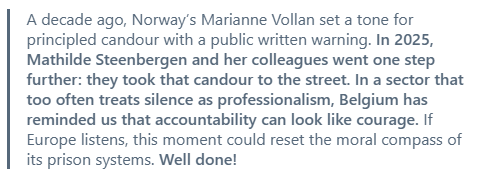Cover image © Belga/Jonas Roosens
Article
In early October 2025, Belgium (SPF Justice/FOD Justitie) did something we don’t see often in the correctional world: frontline officers, prison directors, and the Director‑General of the Prison Service, Mathilde Steenbergen¹, stood together in a public appeal. Outside the central prison administration in Brussels, M. Steenbergen called the action “the first time we have taken action from within the administration itself,” adding that conditions had become “untenable” for staff amid unprecedented overcrowdings².
This wasn’t optics. It was a signal that internal levers were exhausted. The same week, prison directors published an open letter reporting more than 13,000 people held in facilities built for about 11,000, with hundreds sleeping on cell floors. Their demand was blunt: release two prisoners for every new admission until no one is on the floor, then operate one‑in/one‑out to stabilise the population. “The political response, across all parties? Zero,” they wrote³.
Since then, the numbers have continued to move in the wrong direction. By mid‑October, 424 people were sleeping on the floor, with the estate running nearly 20% above capacity. Unions warned that staff were being forced daily to breach the country’s own basic standards for humane detention⁴.
From a practitioner’s vantage point, three things drove Belgium’s leaders into the open:
- A threshold was crossed. “We have never experienced overcrowding as bad as it is today,” the DG said. When a system is literally out of beds, safety and legality fray at once⁵.
- A united chain. Directors and staff moved together- and the Director‑General stood with them, not against them. The action was framed as a cross‑government plea: health, housing, and migration policies are pushing people into prison who “do not belong here,” including those with serious mental‑health needs and people with no fixed address.
- Policy tools weren’t closing the gap. Belgium did pass an emergency law in July 2025 to triage short sentences and expand early release (including release after a third of the term, or after six months with electronic monitoring), while instructing judges to treat prison as a last resort for sentences under three years. Helpful- but not enough against a population spike of this magnitude⁶.
Across Europe, the latest Council of Europe Space Statistics shows that overcrowding is rising. From January 2023 to January 2024, the average density edged up, and 15 prison administrations reported more inmates than places, with several facing severe crowding. In other words, Belgium is part of a wider continental pattern – but few systems have seen their top prison official march alongside line staff to demand relief.⁷ Also across the Americas, the prison population remains large and, in some places, has been ticking up again after pandemic-era dips. Global monitoring by UNODC and independent researchers continues to flag overcrowding as a persistent challenge in the Americas, alongside heavy use of pre‑trial detention. The phenomenon is regional – even global – but public dissent from corrections leadership remains the exception, not the rule.⁸
Belgium’s moment brought to my mind another rare example of leadership candour. In Norway in 2014, Marianne Vollan⁹, and then a much-respected Director General of the Norwegian Correctional Service, wrote an open letter to the Minister of Justice, warning that the system had hit capacity. “The courts are issuing more prison sentences than we can handle,” she said – urging immediate action and acknowledging that some cell space might have to close due to neglect and under‑investment. Another report of her letter captured the plain verdict: “This is a situation we cannot allow to go on.”¹⁰
The comparison matters. Marianne’s move was bold but written; it stayed within Norway’s tradition of policy discourse. Belgium’s step went further and that’s precisely why Belgium’s responsible actions are instructive:
- They framed overcrowding as a public‑safety risk, not just a workplace grievance. The message – “overcrowding is dangerous for us today, for you tomorrow” – connects staff safety, prisoner welfare, and community risk. That integrated framing is what persuades finance ministries and cabinets to act;
- They coupled alarm with solutions. Directors did not merely decry crowding; they proposed temporary release ratios to end floor‑sleeping, then stabilise intake and population at a legal level. That specificity is rare and raises the political cost of inaction;
- They kept the chain of command intact. Mathilde Steenbergen publicly backed the Justice Minister even as she urged broader responses across Government – a calibrated response that maintained operational cohesion.
Belgium has already activated several emergency measures. From a policy and operational standpoint, additional actions – involving different actors across the criminal justice system – could be considered, such as:
- “No floor sleeping” – a non-negotiable KPI. Treat it like a hospital corridor bed: if it occurs, an immediate system-wide triage should activate – including accelerated transfers, expedited releases within existing legal parameters, and temporary capacity measures. This aligns with the prison directors’ temporary “two out for one in” rule until legality and safety are re-established.
- Address the main drivers of population growth. In many European countries, pre-trial detention and short sentences are the fastest-moving components. Belgium’s one-third release rule and presumption of non-custodial measures for sentences under three years point in the right direction. The real impact, however, will hinge on consistent judicial practice, efficient electronic monitoring, and adequate probation capacity.
- Relocate “wrong place” populations. Individuals with acute mental-health needs or without stable housing are over-represented in Belgium’s prisons – an issue flagged by prison leadership. Expanding community beds, secure treatment units, and supported housing pathways can directly reduce turnover and crisis incidents.
- Repatriate foreign sentenced prisoners (EU FD 2008/909/JHA)¹¹. Belgium can transfer convicted foreign nationals to serve their sentences in their countries of origin, under the EU Framework Decision 2008/909/JHA. This allows for sentence enforcement in the prisoner’s home country. It directly reduces Belgium’s inmate population while supporting social reintegration in the home state. To maximize impact, Belgium should streamline procedures, train judicial actors, and prioritize cooperation – even outside the reach of the EU FD – with high-volume partner countries (e.g., Morocco, Romania, Albania).
- Supervise foreign pre-trial detainees in their home country (EU FD 2009/829/JHA)¹². The European Supervision Order enables Belgium to release non-resident defendants under supervision in their home Member State while awaiting trial. This avoids pre-trial detention for foreigners who would otherwise be in prison due to lack of local ties. By transferring supervision abroad, the system ensures both court attendance and reduced remand pressure on Belgian facilities. Greater judicial awareness and operational coordination with EU counterparts are essential for effective implementation.
- Transfer probation and alternative sanctions abroad (EU FD 2008/947/JHA)¹³. Through mutual recognition of probation and alternative sanctions, Belgium can transfer community-based sentences for enforcement in another EU Member State. This prevents foreign offenders from being imprisoned in Belgium merely because community sanctions are hard to supervise across borders. Judges and probation services should receive clear guidance to ensure these transfers are routine practice.
- Expand non-custodial and early-release measures¹⁴. Broaden use of electronic monitoring, and probation to cover more categories of low-risk offenders. Ensure that pre-trial and short-sentence cases are defaulted to community sanctions or home detention whenever legally permissible.¹⁵ Early release schemes for selected groups (e.g., those nearing term completion or undocumented migrants) can quickly free capacity.
- Negotiate international prison capacity agreements. Revisit partnerships like the previous Tilburg Prison arrangement in the Netherlands, or pursue new ones (e.g., Kosovo and Sweden-Estonia models)¹⁶. Such agreements can temporarily house foreign prisoners abroad, easing immediate capacity stress. Belgium authorities may also explore modular or temporary prison units domestically while longer-term reforms take hold.
- Implement a prison population cap (“Numerus Clausus”). Establish a legal rule prohibiting occupancy beyond certified capacity in any Belgian prison. When the cap is exceeded, the system triggers-controlled releases, deferred entries, or electronic monitoring. This ensures “no floor sleeping” as a hard limit rather than an aspiration.
- Push for sentencing and penal code reforms. Introduce reforms to reduce imprisonment for minor and non-violent offenses, such as converting fine defaults into community service. Increase judicial use of suspended and conditional sentences to reduce unnecessary incarceration.
- Reinforce Investment in Rehabilitation, Reentry, and Restorative Justice. Overcrowding is aggravated by recidivism; improving reintegration directly reduces reoffending and returns to prison. Improve security risk classification and periodic recidivism risk and needs assessments to inform sentence planning and progression. Expand educational, vocational, and therapeutic programs¹⁷ both inside prisons and during community supervision. Expand the use of small detention houses. Support halfway houses and housing pathways for released inmates, especially those without stable accommodation. Use inmate data¹⁸¹⁹ to support individual interventions.
- Ensure transparency through public reporting. Publishing a monthly public dashboard tracking total population, floor sleeping, pre-trial numbers, and time to placement changes system-wide incentives and sustains accountability across all ministries influencing the prison population.
It matters that Belgium spoke up. Overcrowding isn’t a Belgian anomaly; it is a European and American reality right now. What is different in Belgium is that the people who run the system said so, loudly, together, and in public. That choice does not make them political actors; it makes them stewards of a safety‑critical public service that had run out of quiet fixes.

References
¹ See the recent interview with Mathilde Steenbergen for the Justice Trends Magazine: Justice Trends Magazine. (2025, October 22). “A meaningful detention experience from day one”: Belgium’s alternative to traditional prisons. See here: https://justice-trends.press/a-meaningful-detention-experience-from-day-one-belgiums-alternative-to-traditional-prisons/
² The Brussels Times. (2025, October 2). Prison staff protest against overcrowding in Belgian prisons. See here: https://www.brusselstimes.com/1774975/prison-staff-protest-against-overcrowding-in-belgian-prisons
³ The Brussels Times. (2025, October 1). Prison Directors demand two inmates be released for every new one. See here: https://www.brusselstimes.com/1772046/prison-directors-demand-two-inmates-be-released-for-every-new-one
⁴ The Brussels Times. (2025, October 16). Union threatens actions against overcrowding in prisons. See here: https://www.brusselstimes.com/1798961/union-threatens-actions-against-overcrowding-in-prisons
⁵ Belga News Agency. (2025, October 2). Prison staff protest against increasing overcrowding. See here: https://www.belganewsagency.eu/prison-staff-protest-against-increasing-overcrowding
⁶ Belga News Agency. (2025, July 15). Belgian parliamentary committee approves emergency law to tackle prison overcrowding. See here: https://www.belganewsagency.eu/belgian-parliamentary-committee-approves-emergency-law-to-tackle-prison-overcrowding
⁷ Council of Europe. (n.d.). Increasing overcrowding in European prisons: Council of Europe’s 2024 annual penal statistics. See here: https://www.coe.int/en/web/portal/-/increasing-overcrowding-in-european-prisons
⁸ United Nations Office on Drugs and Crime. (2025). Prison matters 2025: Global prison population and trends; a focus on rehabilitative environments. United Nations.
⁹ See the interview with Marianne Vollan in 2018: Justice Trends Magazine. (2018, July 24). Full rights citizens: The principle of normality in Norwegian prisons. See here: https://justice-trends.press/full-rights-citizens-the-principle-of-normality-in-norwegian-prisons/
¹⁰ NewsInEnglish.no. (2014, August 21). Packed prisons turn away convicts. See here: https://www.newsinenglish.no/2014/08/21/packed-prisons-turn-away-convicts/
¹¹ See IPS work together with European Criminal Justice partners, supported by EC DG JUST: Rehabilitation of foreign inmates in the EU: cooperation and mutual trust are key. See here: https://prisonsystems.eu/rehabilitation-of-foreign-inmates-in-the-eu-cooperation-and-mutual-trust-are-key/
¹² See IPS work together with European Criminal Justice partners, supported by EC DG JUST: (i) EMPRO Raising awareness and improving the application of FDs 2008/947 and 2009/829. See here: https://prisonsystems.eu/strengthening-the-implementation-of-framework-decisions-2008-947-and-2009-829-in-the-eu-towards-a-more-humane-and-effective-rehabilitation-system/ (ii) PRETRIAD Alternative pre-trial detention measures: Judicial awareness and cooperation towards the realisation of common standards. See here: https://prisonsystems.eu/projects/pre-triad/ (iii) PRE-RIGHTS by DG Justice EU. See here: https://prisonsystems.eu/discussing-pretrial-detention-overuse-and-alternatives/
¹³ See IPS Innovative Prison Systems work together with European Criminal Justice players, with the DG JUST support, including Belgium, in this field here: (i) EUROProspects Ensuring Probationers’ Rehabilitation Prospects via targeted enhancement of the implementation of FD 2008/947. See here: https://prisonsystems.eu/projects/europrospects/ (ii) Creating a more effective and harmonised application of the Framework Decision 2008/947 to improve rehabilitation prospects. See here: https://prisonsystems.eu/projects/ephesus/ (iii) Enhancing outcomes for Justice-involved foreign individuals through international judicial cooperation. See here: https://prisonsystems.eu/enhancing-outcomes-for-justice-involved-foreign-individuals-through-international-judicial-cooperation/ (iv) Enhancing Mutual Recognition of Non-Custodial Sentences in the EU through increased awareness. See here: https://prisonsystems.eu/enhancing-mutual-recognition-of-non-custodial-sentences-in-the-eu-through-increased-awareness/ (v) Exploiting Digitalisation to Increase the Use of Framework Decision 2008/947. See here: https://prisonsystems.eu/exploiting-digitalisation-to-increase-the-use-of-framework-decision-2008-947/
¹⁴ See IPS work together with European Criminal Justice partners, supported by EC DG JUST: (I) PRETRIAD Alternative pre-trial detention measures: Judicial awareness and cooperation towards the realisation of common standards. See here: https://prisonsystems.eu/projects/pre-triad/
¹⁵ Adequate investment in probation staffing and electronic monitoring infrastructure will ensure these alternatives are viable.
¹⁶ These should comply with European detention standards and be used as short-term safety valves rather than permanent outsourcing.
¹⁷ Embedding restorative justice and cognitive-behavioral interventions can turn sentencing into a process of repair, not warehousing.
¹⁸ See IPS Innovative Prison Systems work supported by DG Justice: Understanding recidivism and exploring AI’s potential in reducing reoffending. See here: https://prisonsystems.eu/understanding-recidivism-and-exploring-ais-potential-in-reducing-reoffending/
¹⁹ See IPS work of offender management systems Towards an intelligent Offender Management System. here: https://prisonsystems.eu/towards-an-intelligent-offender-management-system/

Pedro das Neves is the CEO of IPS Innovative Prison Systems and Director of ICJS Innovative Criminal Justice Solutions. With over 20 years of experience, he has led justice reform initiatives across Europe, North America, Latin America, the Middle East, and Central Asia. Pedro has worked extensively with governments, the UNODC, the European Commission, and the Inter-American Development Bank (IDB), focusing on offender management, risk assessment, PCVE, and the modernization of correctional systems. He is an expert in designing and implementing AI-powered tools and digital solutions, such as the HORUS 360 iOMS, aimed at enhancing security, rehabilitation, and reducing recidivism. Pedro is the founder and editor-in-chief of JUSTICE TRENDS magazine and serves as a board member of the International Corrections and Prisons Association (ICPA). His contributions have earned him prestigious awards, including the ICPA Correctional Excellence Award. Pedro holds advanced qualifications from renowned institutions, including the College of Europe, the University of Virginia (Digital Transformation), MIT (Digital Transformation), and the University of Chicago (Artificial Intelligence), cementing his position as a leader in innovation and digital transformation within the justice sector.


